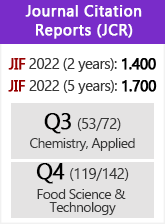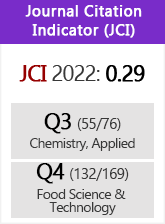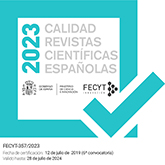Volatile constituents and oxidative stability of virgin olive oils: influence of the kneading of olive-paste.
DOI:
https://doi.org/10.3989/gya.1999.v50.i1.632Keywords:
Crushing, Oil-olive paste separation, Olive, Oxidative stability, Paste kneading, Virgin olive oil.Abstract
La molienda de aceitunas, el batido de la pasta y la separación del aceite de oliva producen una serie de transformaciones en las características del aceite que posteriormente será extraído. Es sabido que la formación de distintos componentes del aroma del aceite derivan de reacciones oxidativas enzimáticas. El contacto entre el aceite y la pasta de aceitunas incrementa la lipolisis y la oxidación lipídica, debido a un incremento de la actividad de las lipasas presentes en la pasta y a una acción lipoxigenásica respectivamente. La elección de los parámetros tecnológicos está en relación directa con la futura estabilidad y las características organolépticas del aceite. En este trabajo se confirma la formación de tales compuestos evidenciándose la degradación oxidativa del aceite en relación al tiempo de batido empleado. Se demuestra también una pérdida de antioxidantes (componentes polares menores) por efectos oxidatives en modo proporcional al tiempo de batido.
Downloads
Download data is not yet available.
Downloads
Published
1999-02-28
How to Cite
1.
Lercker G, Frega N, Bocci F, Mozzon M. Volatile constituents and oxidative stability of virgin olive oils: influence of the kneading of olive-paste. Grasas aceites [Internet]. 1999Feb.28 [cited 2024Jul.22];50(1):26-9. Available from: https://grasasyaceites.revistas.csic.es/index.php/grasasyaceites/article/view/632
Issue
Section
Research
License
Copyright (c) 1999 Consejo Superior de Investigaciones Científicas (CSIC)

This work is licensed under a Creative Commons Attribution 4.0 International License.
© CSIC. Manuscripts published in both the printed and online versions of this Journal are the property of Consejo Superior de Investigaciones Científicas, and quoting this source is a requirement for any partial or full reproduction.All contents of this electronic edition, except where otherwise noted, are distributed under a “Creative Commons Attribution 4.0 International” (CC BY 4.0) License. You may read here the basic information and the legal text of the license. The indication of the CC BY 4.0 License must be expressly stated in this way when necessary.
Self-archiving in repositories, personal webpages or similar, of any version other than the published by the Editor, is not allowed.
















